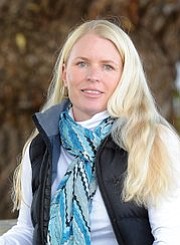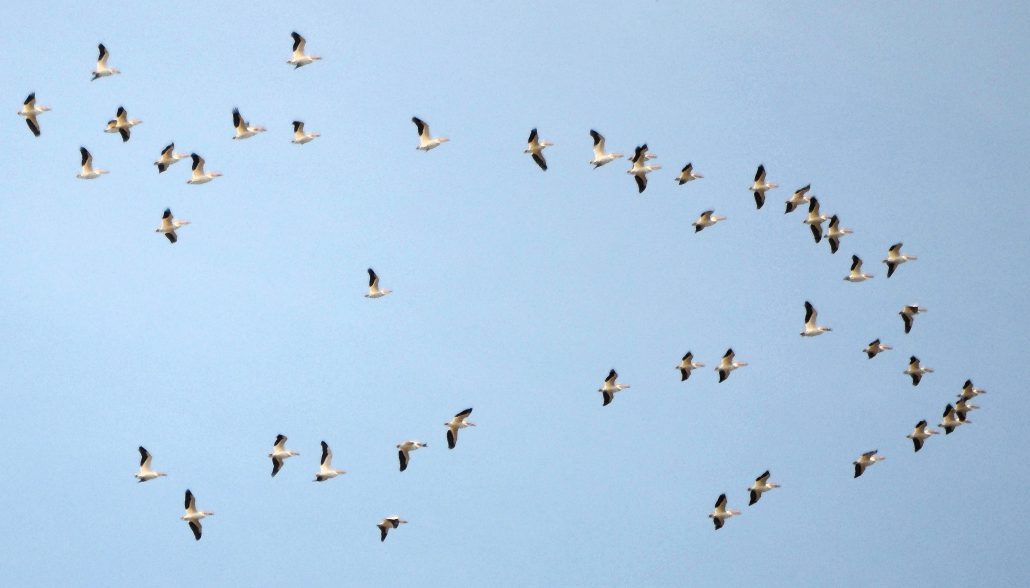
American White Pelicans migrate across North America, from Canada to Central America. This is just one of 15 colonial waterbird species we monitor as part of our ColonyWatch Citizen Science project. Photo by Emily Gubler.
By Sonja Macys, Development Director
I have always been fascinated by bird migration. As a child, I remember asking my parents how they knew where to go?
Of course, their answer was “they just do.”
While we know more about migration today, annual bird migrations still hold many mysteries. That’s probably a good thing! It’s important to be awed at the marvels of nature from time to time. However, for conservation efforts to succeed, we do need to know more—including where these birds go, where they stop along the way to eat and rest, and what hazards and challenges they encounter. Sometimes, the answers are found far from home, as many of the birds we consider to be “ours” spend significant time in other countries.
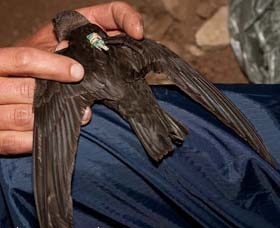
Tiny geolocators attached to Black Swifts revealed the location of their winter migration destination in Brazil in 2012. Photo by Todd Patrick
One of the exciting things about working at Bird Conservancy of the Rockies is having a front row view as our scientists unlock these mysteries. Our work is truly on the cutting edge. The story of the Black Swift is particularly impressive to me. The collaborative research we participated in led to the first documented migratory path and wintering area for this species—the Amazon Basin of Brazil. The discovery resulted in the bird being listed on Brazil’s ornithological register for the first time. Each discovery reveals a need to know more so we can better protect and conserve the species and habitats that support it. It’s my natural curiosity about Black Swifts that inspired me to contribute a to a campaign led by Bird Conservancy to find out more about the Black Swift’s movement and ecology. If you’d like to learn more about that project, follow this link.
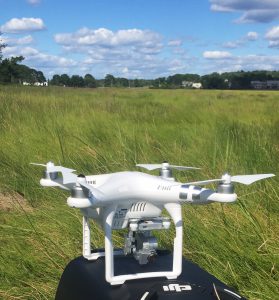
Technological advances and tools are spurring innovation in bird conservation – but it takes investment!
It’s astounding how technology used in tracking birds has advanced. For example, our International Team just announced plans to expand their monitoring efforts by using drones as flyover cameras. Using aerial photography to document and track birds isn’t new. We’ve used aerial photos before, thanks to the generosity of Lighthawk pilots flying us around for that purpose. However, when you compare the cost, time, and carbon footprint between a manned flight and that of a drone, the drone is much more efficient, less obtrusive to the birds, and capable of getting closer to the action. Outfitted with a high-resolution digital camera capable of shooting practically unlimited photos, this approach promises to yield not only better images but also more comprehensive data.
As we enter the season of gratitude, if you feel grateful for innovative research approaches and would like to support our scientists who keep us on the leading edge of bird conservation and science, I hope you will join us on Colorado Gives Day and pledge your support to our organization as a whole, or to one of the many project-specific campaigns. Early birds can even pre-schedule their donation now to take place on Colorado Gives Day. It’s so easy—and every dollar you give through Colorado Gives helps us qualify for incentive funds that boost our overall fundraising campaign.
 Another option is to make a regular monthly contribution. For as little as $10 a month, you can show your support for Bird Conservancy and by the end of the year will have donated enough to send four children to a day of summer camp! Monthly giving provides much-needed support for our work throughout the year. Our operations follow annual cycles just like the birds. Seasonally, we deploy nearly fifty scientists to search for birds and document them, and that intense burst of activity requires healthy finances. Sustained support helps meet those needs. And, you can rest assured that contributions are used responsibly and leveraged against other funding to get the maximum possible impact for every dollar spent.
Another option is to make a regular monthly contribution. For as little as $10 a month, you can show your support for Bird Conservancy and by the end of the year will have donated enough to send four children to a day of summer camp! Monthly giving provides much-needed support for our work throughout the year. Our operations follow annual cycles just like the birds. Seasonally, we deploy nearly fifty scientists to search for birds and document them, and that intense burst of activity requires healthy finances. Sustained support helps meet those needs. And, you can rest assured that contributions are used responsibly and leveraged against other funding to get the maximum possible impact for every dollar spent.
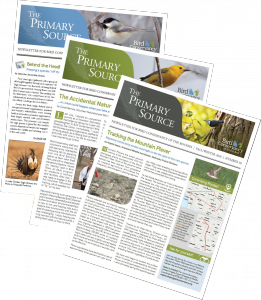 If you’ve read this far, you’re clearly interested in the work that we do! Perhaps you know others who would be interested in hearing the stories of how farmers and ranchers are saving Mountain Plovers or learning how Eastern Screech-Owls help us understand more about riparian health. Why not share your enthusiasm about Bird Conservancy with a friend or family member? I did. And she was thrilled! You can give a gift membership online, or call us at 970-482-1707 ext. 30 or email [email protected]. We’ll let them know about your generous gift. They will receive The Primary Source newsletter twice a year, as well as invitations and discounts to our annual member picnic, birding trips and other special member events.
If you’ve read this far, you’re clearly interested in the work that we do! Perhaps you know others who would be interested in hearing the stories of how farmers and ranchers are saving Mountain Plovers or learning how Eastern Screech-Owls help us understand more about riparian health. Why not share your enthusiasm about Bird Conservancy with a friend or family member? I did. And she was thrilled! You can give a gift membership online, or call us at 970-482-1707 ext. 30 or email [email protected]. We’ll let them know about your generous gift. They will receive The Primary Source newsletter twice a year, as well as invitations and discounts to our annual member picnic, birding trips and other special member events.
As we enter this season of gratitude, I am truly grateful for all of the individuals who make the work of organizations like ours possible. Without philanthropic-minded folks, our scientists could not help keep us ahead of the curve with what’s happening in the world of birds. Thanks for being part of our flock! We hope you’ll help us broaden the circle.


